Retail Holiday Newsletter

概要
- Retailers logged record sales this November, with in-store sales up 3.3% and e-commerce sales more than 16% higher than a year earlier.
- Marketing efforts are key to holiday sales—fourth-quarter media spending is typically 32% higher than the average for the first three quarters of the year.
- In this issue, we show that the new customers that retailers acquire during the holidays are less valuable than those earned during the rest of the year, and we explore the ways retailers are trying to increase the lifetime value of new customers.
Holiday sales keep retailers jolly
With Christmas only days away, retailers are getting ready to log another successful holiday season. Despite recent stock market volatility, consumers remain confident about the economy and are spending more in stores and online.
November in-store sales jumped 3.3%. While online shopping growth generates the most attention, in-store sales in Bain-defined retail categories grew a healthy 3.3% this November, compared with last year, according to advanced sales estimates from the US Census Bureau. This is just shy of the 3.5% to 3.7% growth we forecasted for in-store sales this holiday season. Electronics retailers grew the fastest, at 5.0% vs. last November. General merchandise retailers, which include companies such as Walmart and Target, grew 4.2%, the second-fastest-growing category.
Store foot traffic is up this season. The number of store shoppers visiting the 10 major retailers we tracked with the help of Placer.ai climbed 1.4% between November 1 and December 11, compared with the year-earlier period. Traffic is also up 3.6% from a year earlier at the 900 shopping centers, outlets and malls that we tracked. This growth was most pronounced for higher-end A- and B-grade malls, where traffic grew 4.8% during this period. Lower-end C- and D-grade malls saw a 0.2% decrease.1
Online sales continue to soar. Sales through websites increased 16.4% between November 1 and December 6, compared with the same period last year, according to Adobe Analytics. Sales were lifted by slightly higher web traffic, as well as increases in conversion rates and basket sizes. Retailers converted website visits into sales at an 8% higher rate in key gift categories in November than a year earlier (up 91 basis points from 11.4% last year), according to our analysis of data from online data firm Jumpshot. Conversion rates increased the most in the toys and games category (see Figure 1). On the mobile front, more shoppers are turning to apps for holiday shopping. The number of daily average users for the top 50 Android apps in retail rose 14% between November 1 and December 11, compared with last year, according to data from market-intelligence firm SimilarWeb.
Online conversion rates for key gift categories have grown an average of 8% since last year
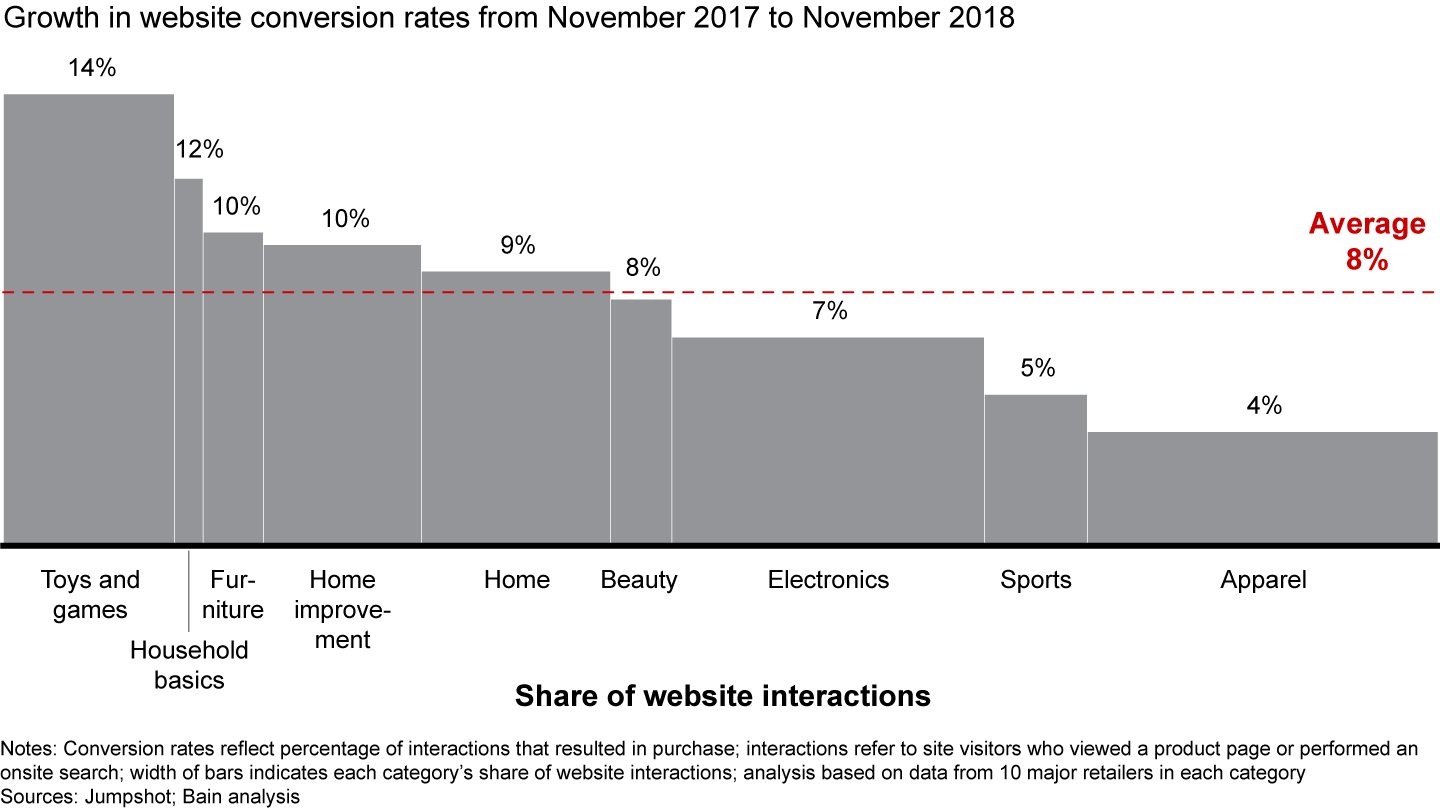
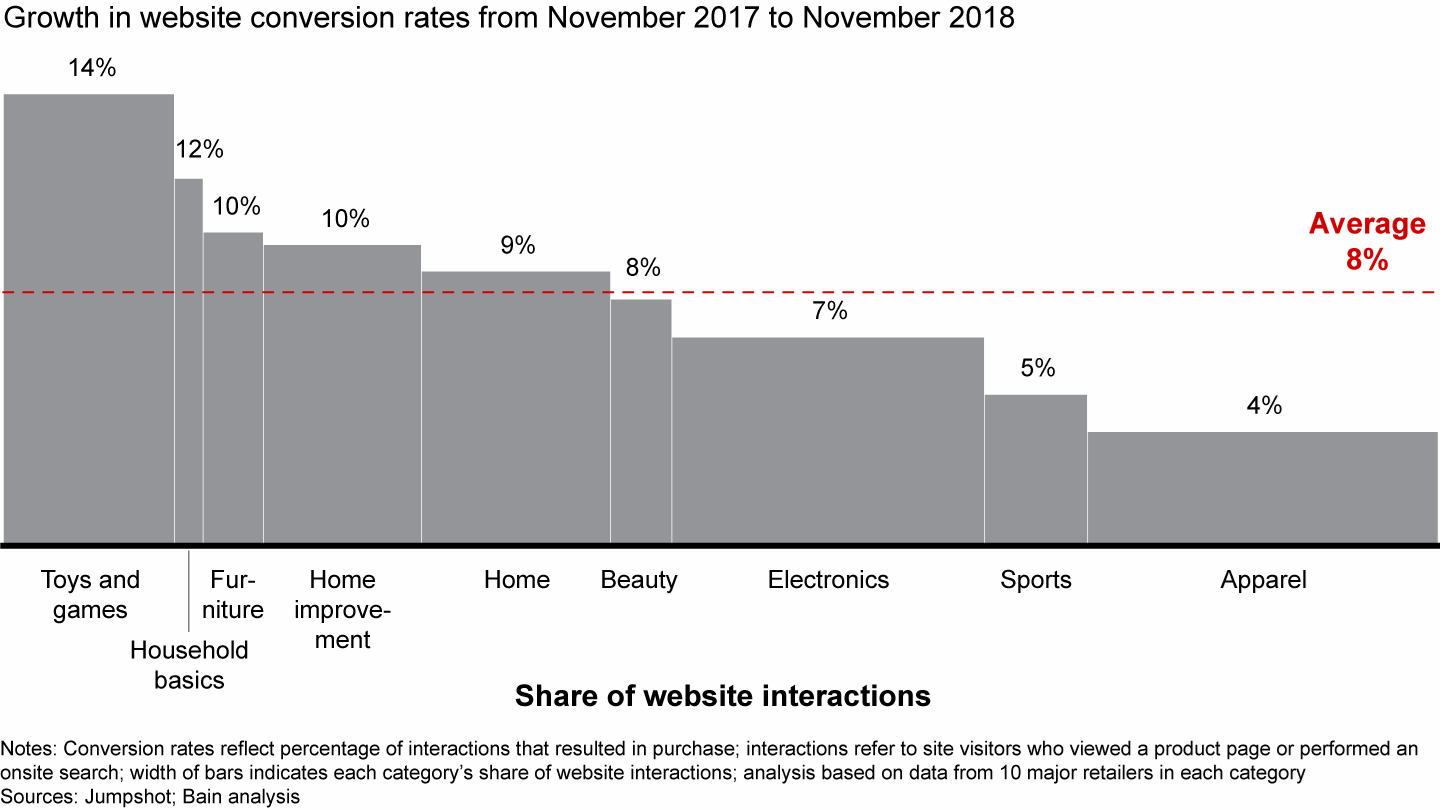
Marketing to the 2018 holiday shopper
It’s a chilly Monday in Boston, and working mom Abby is scrolling through Instagram to pass the time as she waits for the train to take her to the office. She smiles as she taps through a friend’s funny Instagram “story”—a short series of annotated photos and videos—about tacky Christmas sweaters. Before she moves on to the next story, one about a new book from her favorite author, she spots a story from a specialty retailer where she frequently shops. It highlights top gift ideas, including several products she has been browsing in recent weeks, such as French candles and cashmere pajamas. The next item, a classic black dress, is intriguing enough to prompt her to visit the retailer’s site. When the site launches, she sees that the dress is available for pickup in her size at a store a few blocks away. She puts it on hold and decides to pop over during lunch. She then checks her email and while reading an article, clicks a link to an embedded holiday video. Before the video loads, she watches a 15-second advertisement from a retailer whose website she visited yesterday. As she gets to the office, she receives email confirmation of her noon dressing room slot, with a note that the retailer will also provide shoes in her size and some accessories to try on with the dress.
This is marketing today. This season, most retailers will be using their holiday marketing budgets to target potential shoppers wherever they are, whether they are reading the news on their phones or watching videos on social media. However, tomorrow’s industry leaders are going further to retain new customers, deepen existing relationships and build the data infrastructure that will power their marketing decisions for holiday seasons to come.
TV advertising is still king, but digital is ramping up
Retail media spending has declined 1.6% a year, on average, from 2014 to 2017, even as sales rose 3.8% (see Figure 2). And while overall fourth-quarter retail media spending has declined 0.2% annually, consumers are right to feel inundated with holiday ads—media spending in the fourth quarter exceeded quarterly spending for the rest of the year by an average of 32% from 2014 to 2017, while sales rose 15%. We forecast this year’s fourth-quarter media spending to outpace last year’s by 3%, based on spending increases from a sample of retailers we tracked with the market-intelligence firm Numerator.
Retail media spending in the US decreased 1.6% annually from 2014 to 2017, while sales rose 3.8%
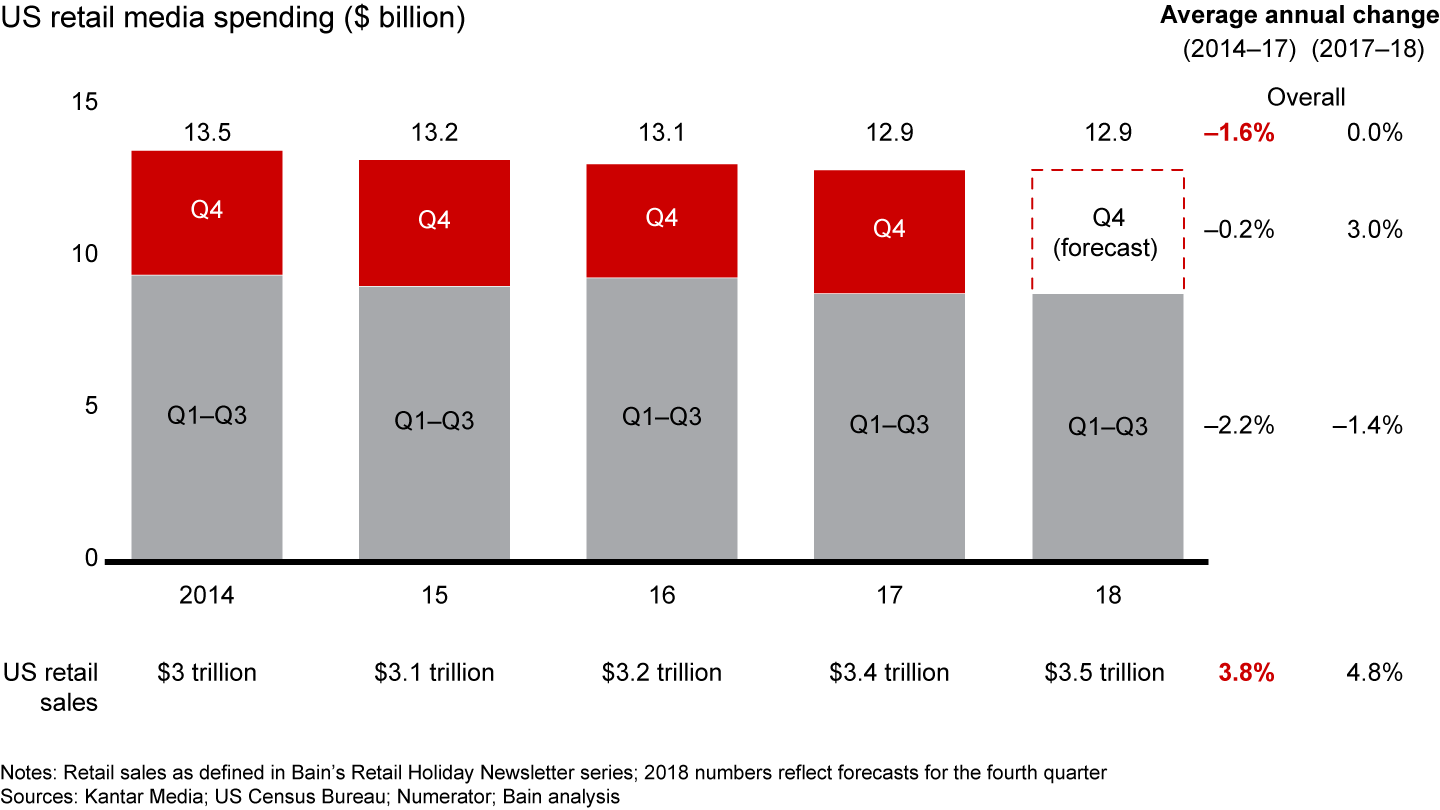
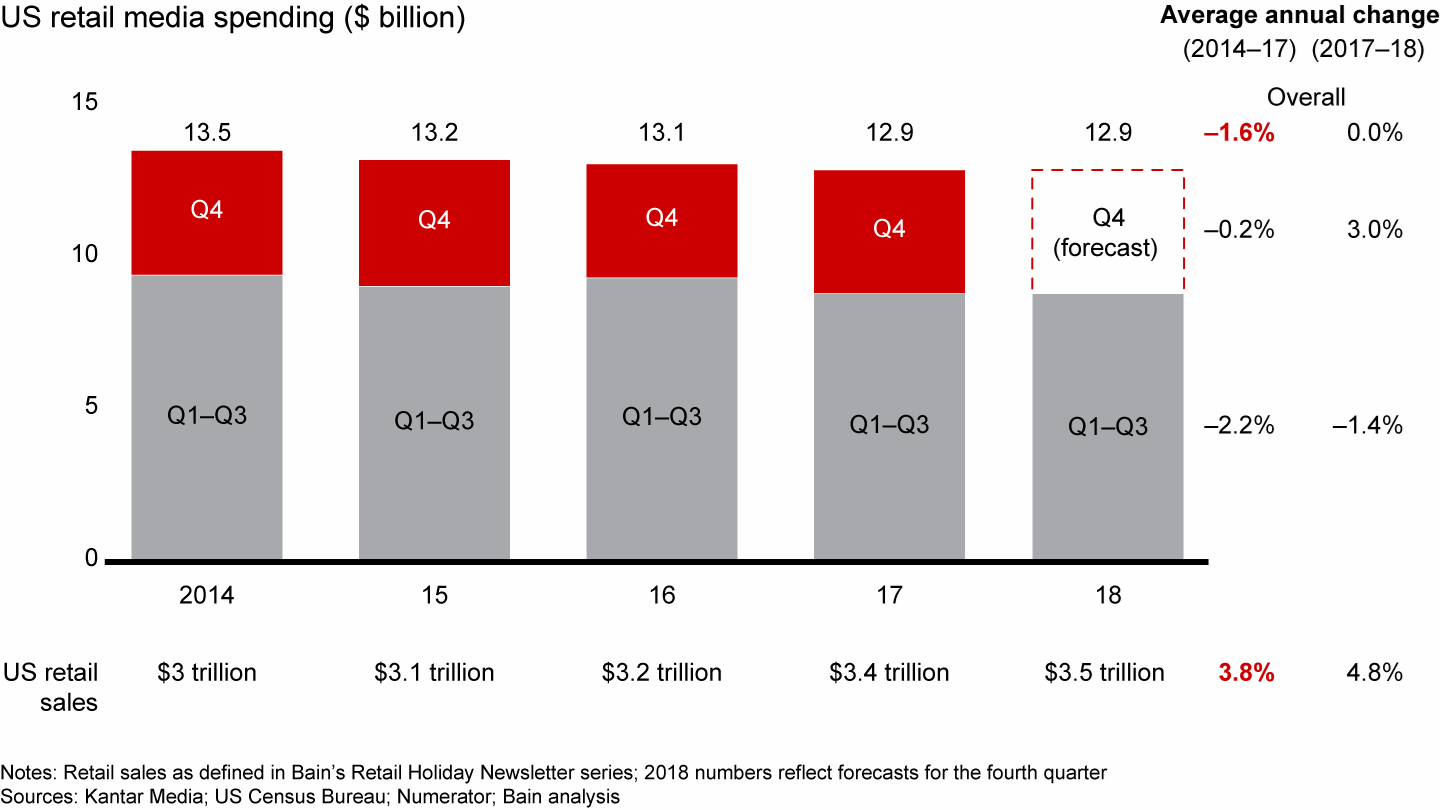
Retailers that sell products in popular gift categories, such as consumer electronics and apparel, experience fourth-quarter sales surges and tend to boost their fourth-quarter media spending most (see Figure 3). Amazon also ratchets up media spending during the holiday months to draw Prime members, who increase their monthly spending by more than 50% (see "Is Amazon Primed to Conquer Christmas Again?"). In contrast, home improvement and convenience stores, which serve immediate needs, do not experience the same revenue spikes and keep their media spending more consistent year-round.
Retailers with the biggest surge in seasonal revenue typically increase their media spending the most in the fourth quarter
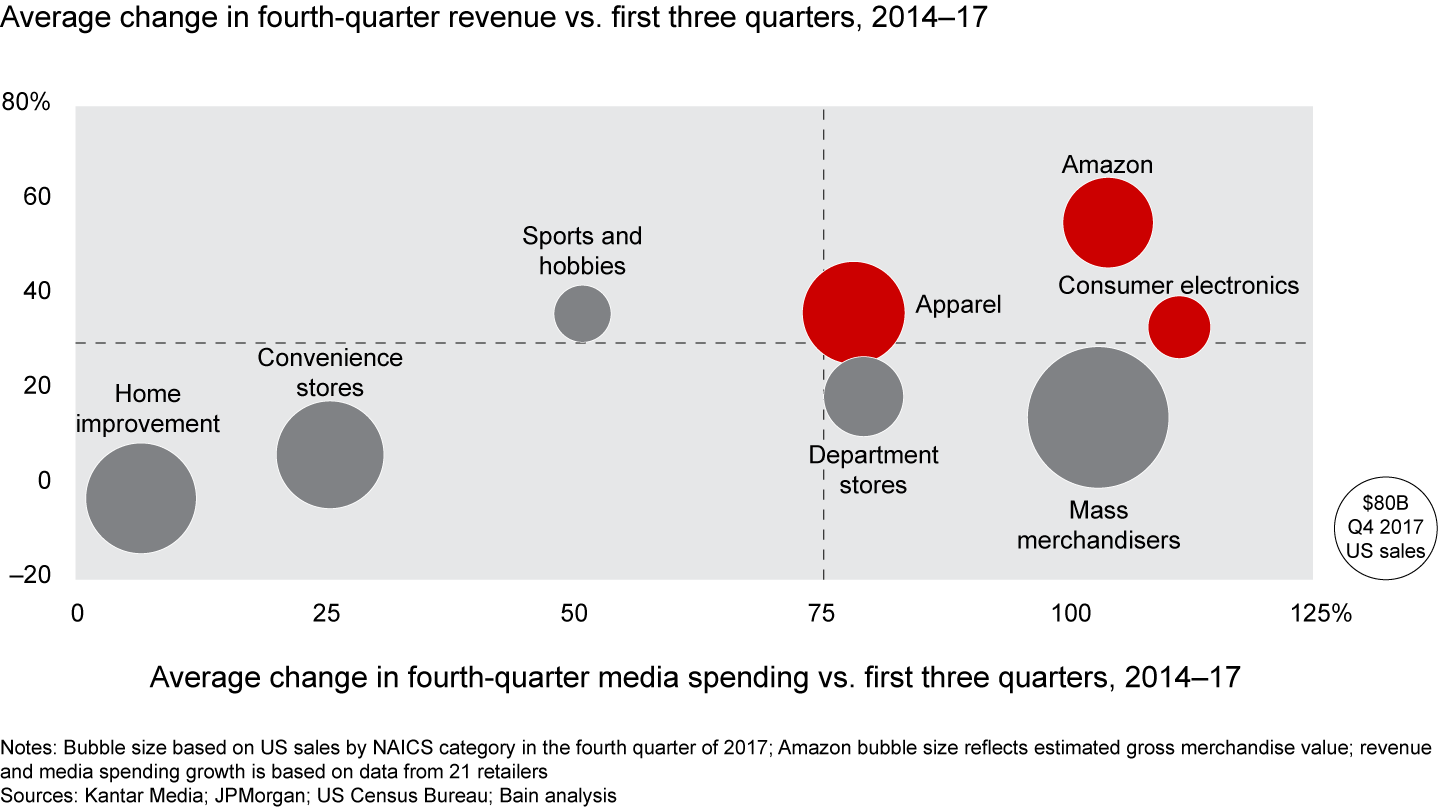
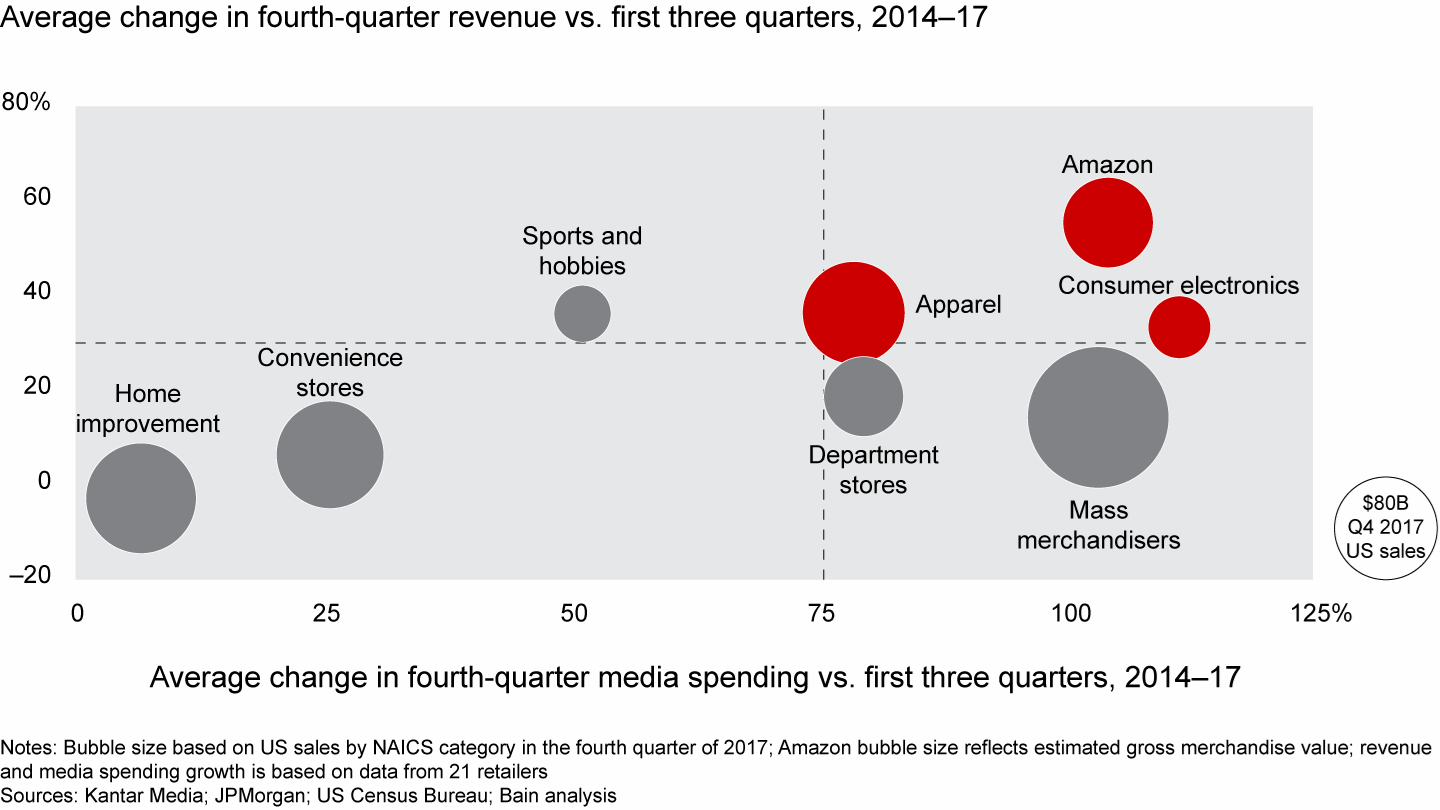
While retailers typically increase their media spending during the fourth quarter, their preferred channels are evolving. Television advertising has historically been the promotional medium of choice for retailers, especially during the holidays. From 2014 to 2017, TV ad purchases made up 41% of retail media spending during the fourth quarter, up from 36% during the first three quarters of the year. But retailers have been gradually shifting away from TV, cutting holiday spending 3% a year during that time period. The mix shifted most aggressively in 2017, when digital channels captured an additional 8.6 percentage points of retail holiday media spending.
Early evidence suggests this shift has continued into the 2018 holiday season. Media spending on TV and other traditional channels—including radio, print and outdoor ads—has been falling this holiday season in favor of digital advertising, based on data from nine retailers that we analyzed with Numerator. While we expect spending on traditional channels this holiday season to decline more than 3% from a year earlier, we predict that spending on digital ads—including display, video and search—will grow almost 14%, with online display and video ads growing fastest (see Figure 4). Digital ads will likely command as much as 38% of these retailers’ ad budgets this holiday season, up 4 percentage points from the 2017 period.
Holiday retail media spending will continue to shift to digital in 2018
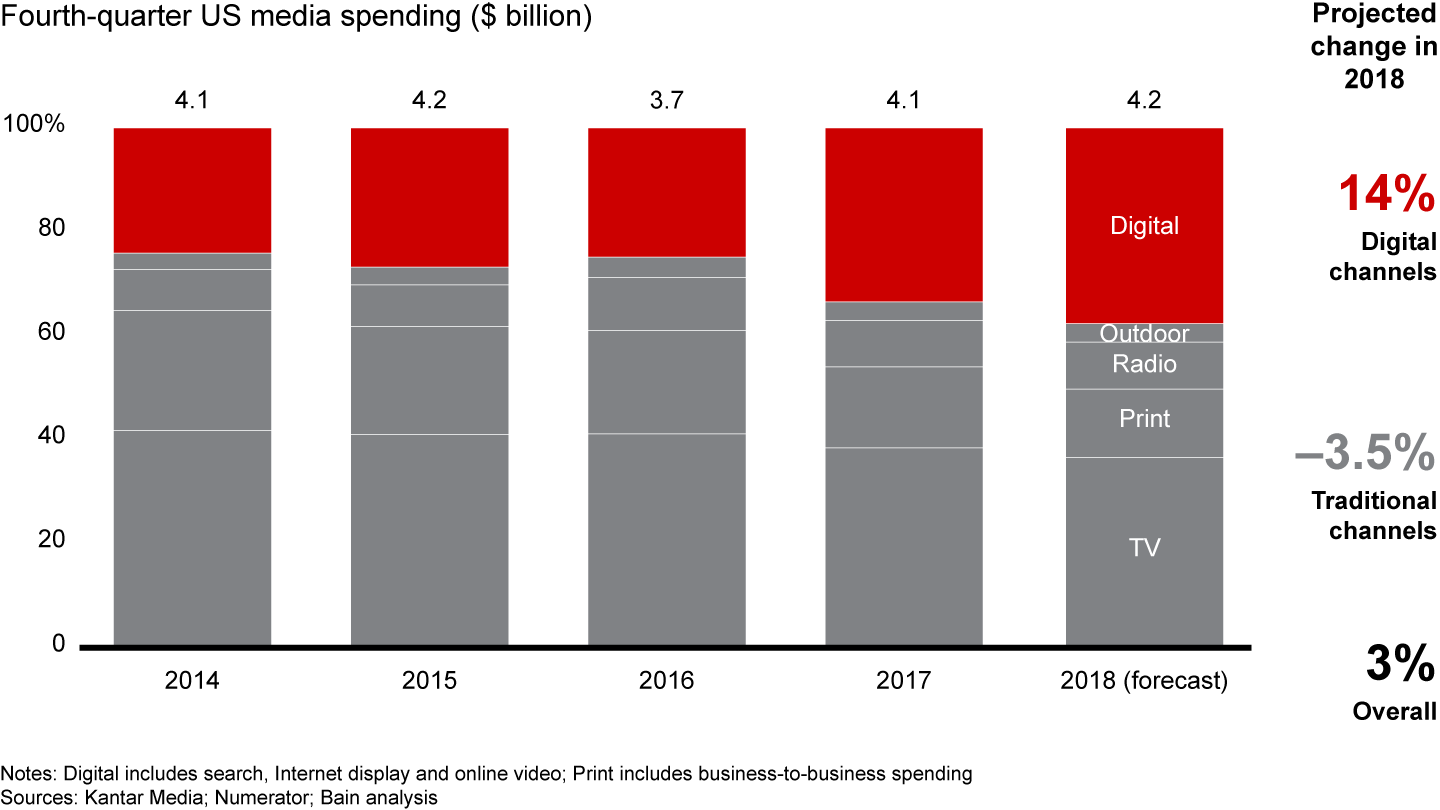
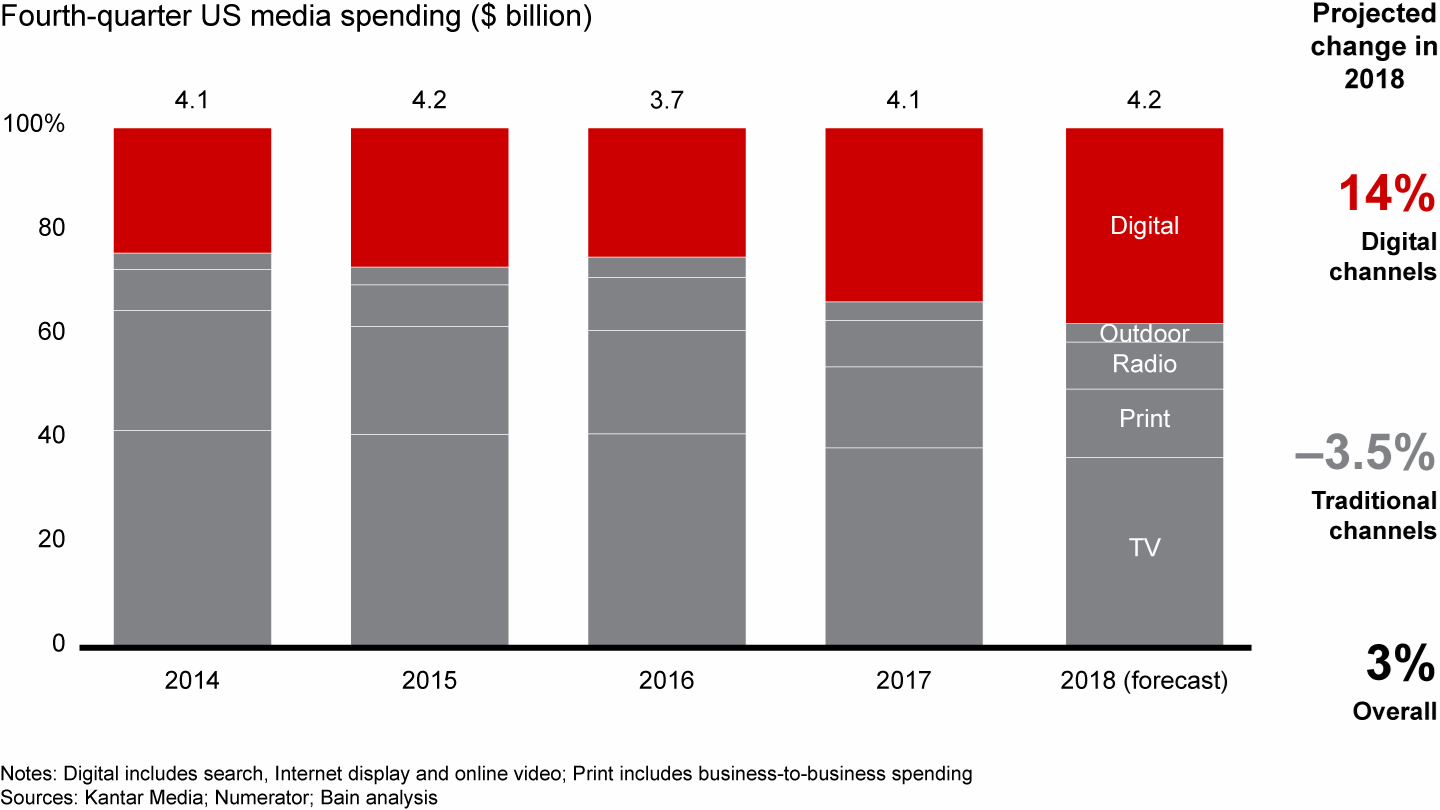
With 80% of marketers using video ads this holiday season, consumers are bound to notice. Recent research by the online video tool Animoto suggests that consumer brand videos influence the holiday buying decisions of more than half of their viewers. With that in mind, retailers are experimenting with formats ranging from short, punchy clips, like familiar six-second “bumper ads,” to longer-form narratives that resemble short films. They are also testing new social video channels, such as Instagram’s IGTV, which features videos that exceed the traditional 60-second cap. Walmart recently published a series of three- to five-minute videos on IGTV in which Santa gives shopping advice to customers, promoting the retailer’s toys, holiday-themed decorations and Black Friday deals.
Social media has been a particular draw for retail advertisers, with almost 80% of marketers planning to run a holiday-related social campaign this season. Media research firm MAGNA expects spending on social media advertising to increase 30% in 2018. Unlike TV commercials, social media offers retailers an opportunity to target key buyer groups with relevant products and direct links to purchase gift ideas. Almost three-quarters of people surveyed by Animoto said that social media influenced their buying decisions. And Facebook estimates that consumers post 26% more often during the holiday months as they trade Christmas greetings and look for gift ideas.
The Instagram or Facebook “story”—collections of images or brief videos that disappear after 24 hours—has been taking retailers by storm. Sponsored stories, which target users based on demographics, have become the most popular new advertising vehicle for retailers this holiday season, according to digital ad tools ClickZ and Kenshoo. More than one-third of consumer brands have included sponsored stories in their holiday marketing plans this year. Nordstrom Rack recently posted an interactive series of Instagram stories that invited users to tap their phones to remove on-screen snow to reveal a deal of the day.

Retail Holiday Newsletter 2018
Bain’s annual Retail Holiday Newsletter series looks at the tactics and innovations that retailers are using to attract and delight shoppers.
Many new customers, but with lower customer lifetime values
With most retailers buying more ad units during the holidays, the cost can jump by as much as 20% to 30%, compared with the rest of the year. This plays out across all channels, including social media, where the cost per thousand impressions spiked 22% during the fourth quarter last year. The cost per click for search engine ads was also 9% higher during last year’s holiday season than the quarter that followed it.
While retailers are absorbing higher media costs, the new customers they acquire during the holidays are less valuable. They are less likely to return than customers earned at other points in the year, reducing their customer lifetime value, which is the amount they are likely to spend at the retailer during their entire relationship. To see how this pattern plays out over years, we worked with Earnest Research to analyze buyer spending during the 24 months after a customer’s initial purchase month at 21 major retailers. Customers acquired during November and December typically spend 15% to 20% less during the subsequent two years because they return to the retailer less often (see Figure 5).
Compared with customers acquired the rest of the year, new holiday customers spend less and make fewer transactions in subsequent years
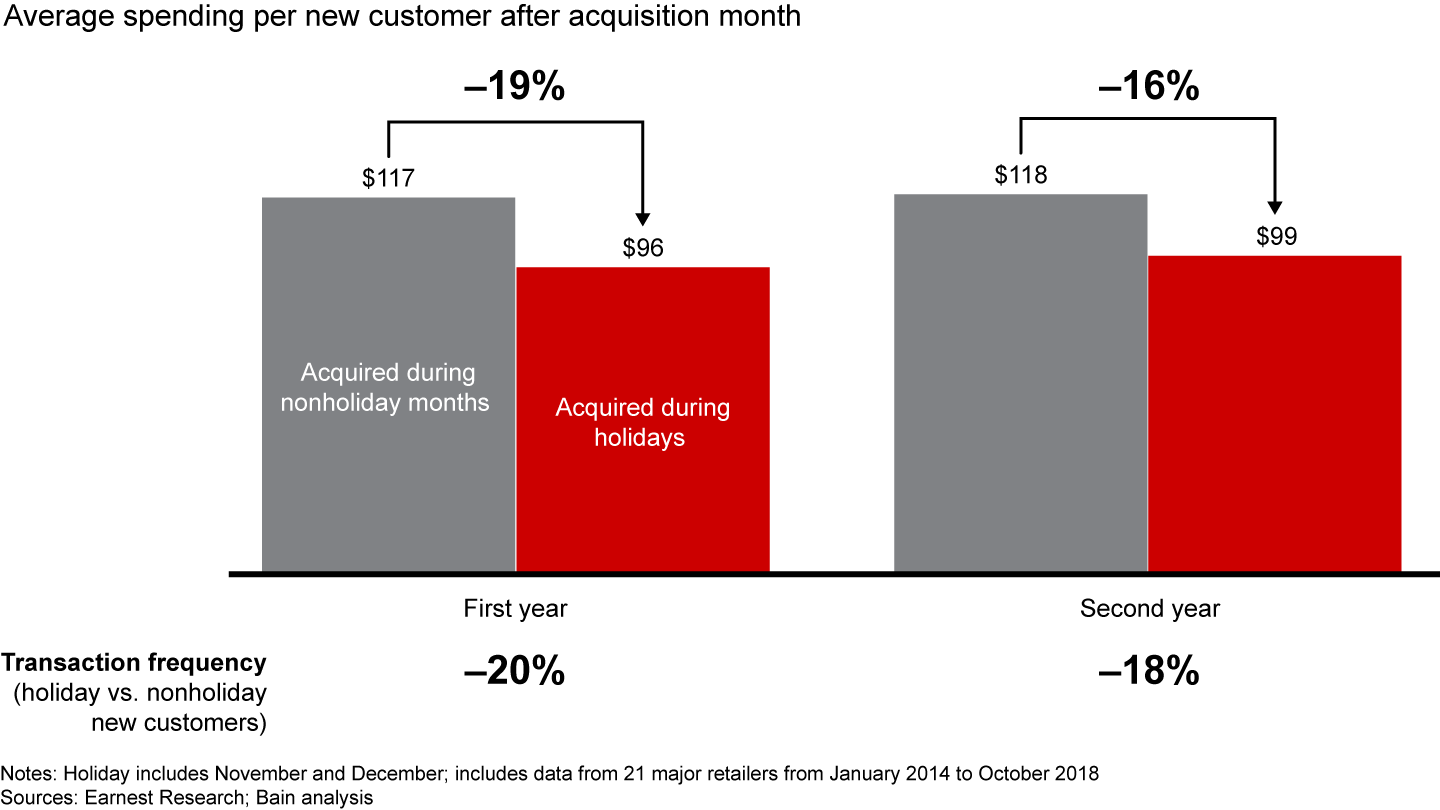
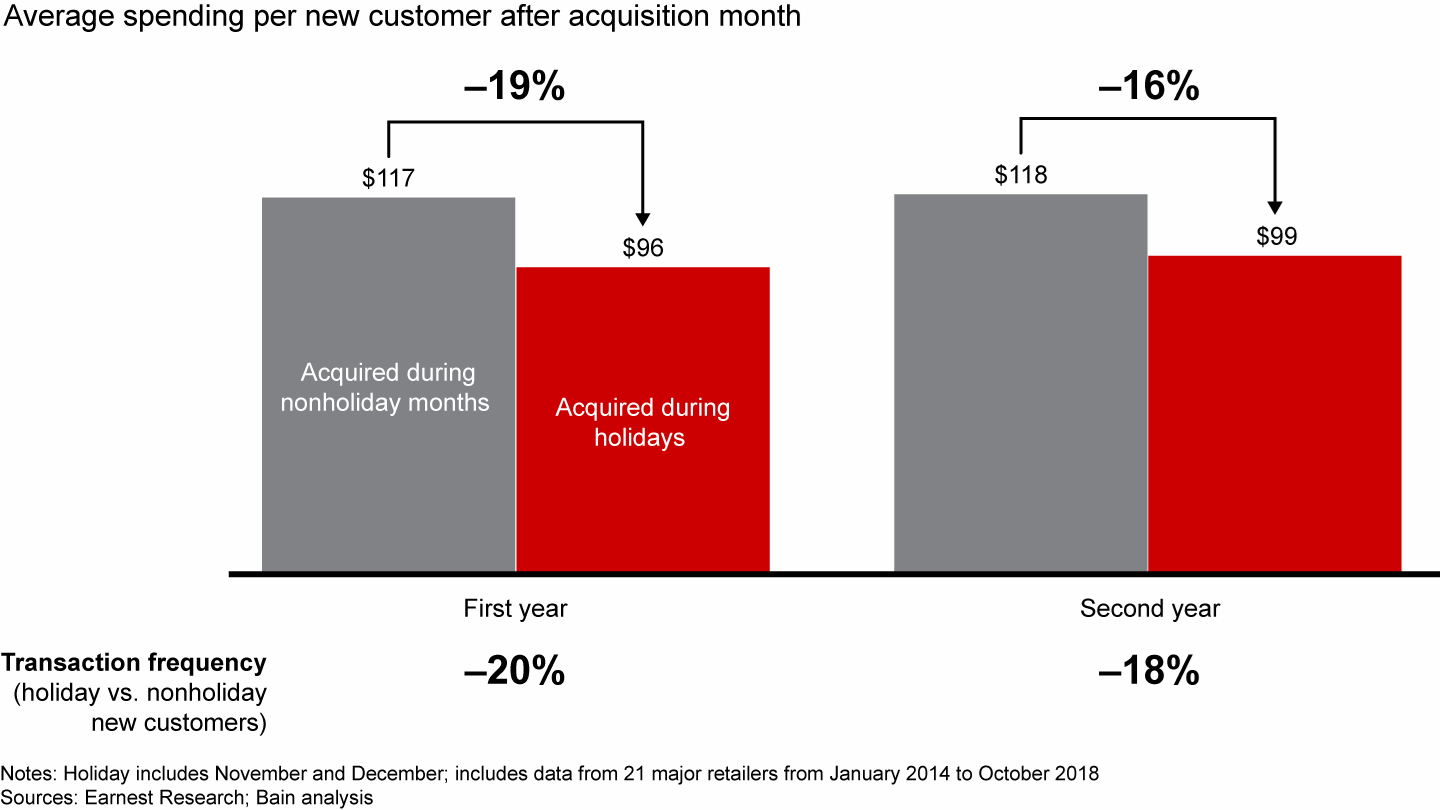
Consumer electronics retailers experience the largest drop in future spending, with customers acquired during the holidays spending almost 30% less during the subsequent 12 months (see Figure 6). While the flurry of holiday promotions and discounts might draw new customers to popular gift categories, customers acquired during the rest of the year are more likely to return outside of the holiday deal season. However, Amazon seemingly remains impervious to this effect: New customers gained during the holidays spend only 2% less in later months than those earned during the rest of the year, suggesting that the right strategy and tactics can narrow the gap.
In the first year, new holiday customers spend less than customers acquired the rest of the year, especially at mass merchandise and electronics retailers
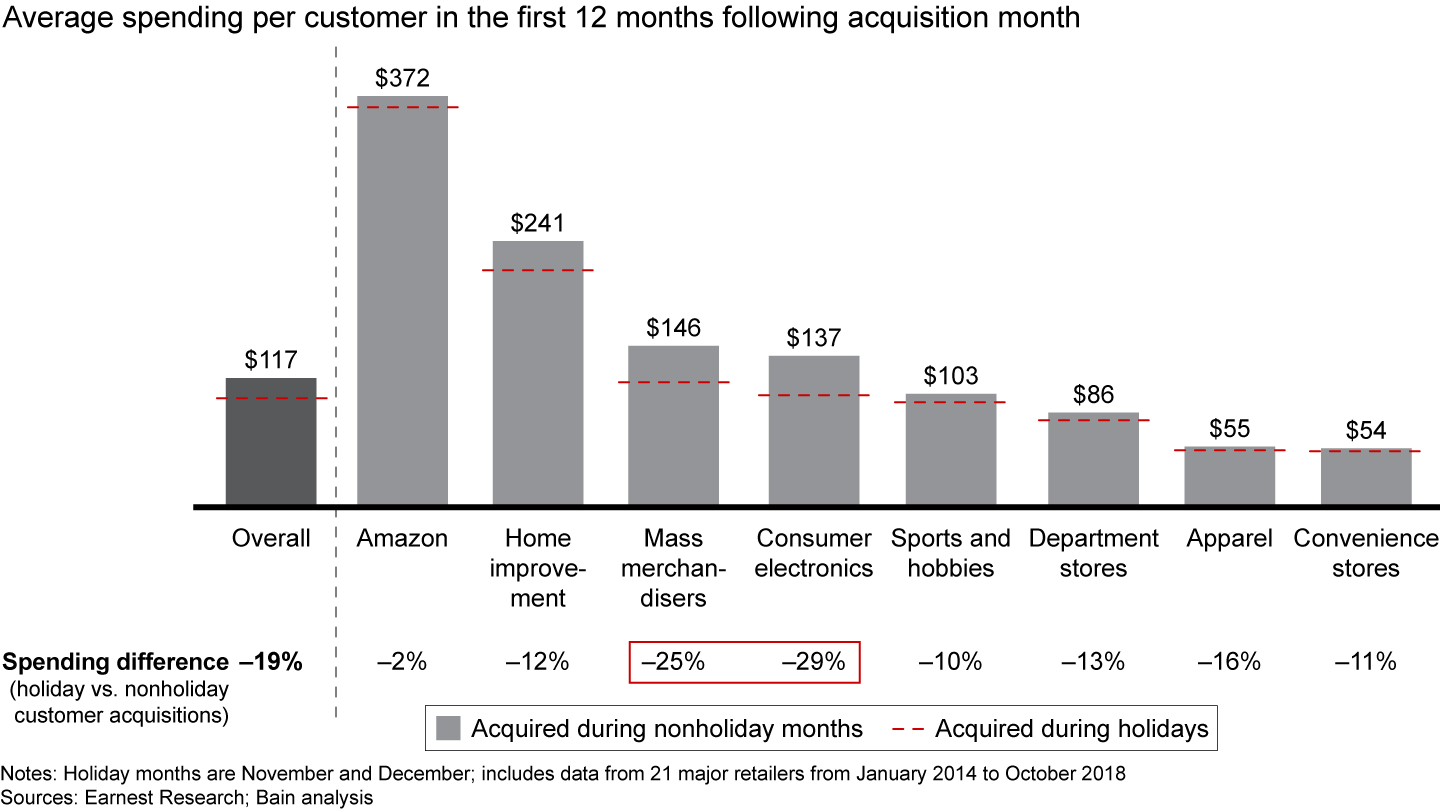
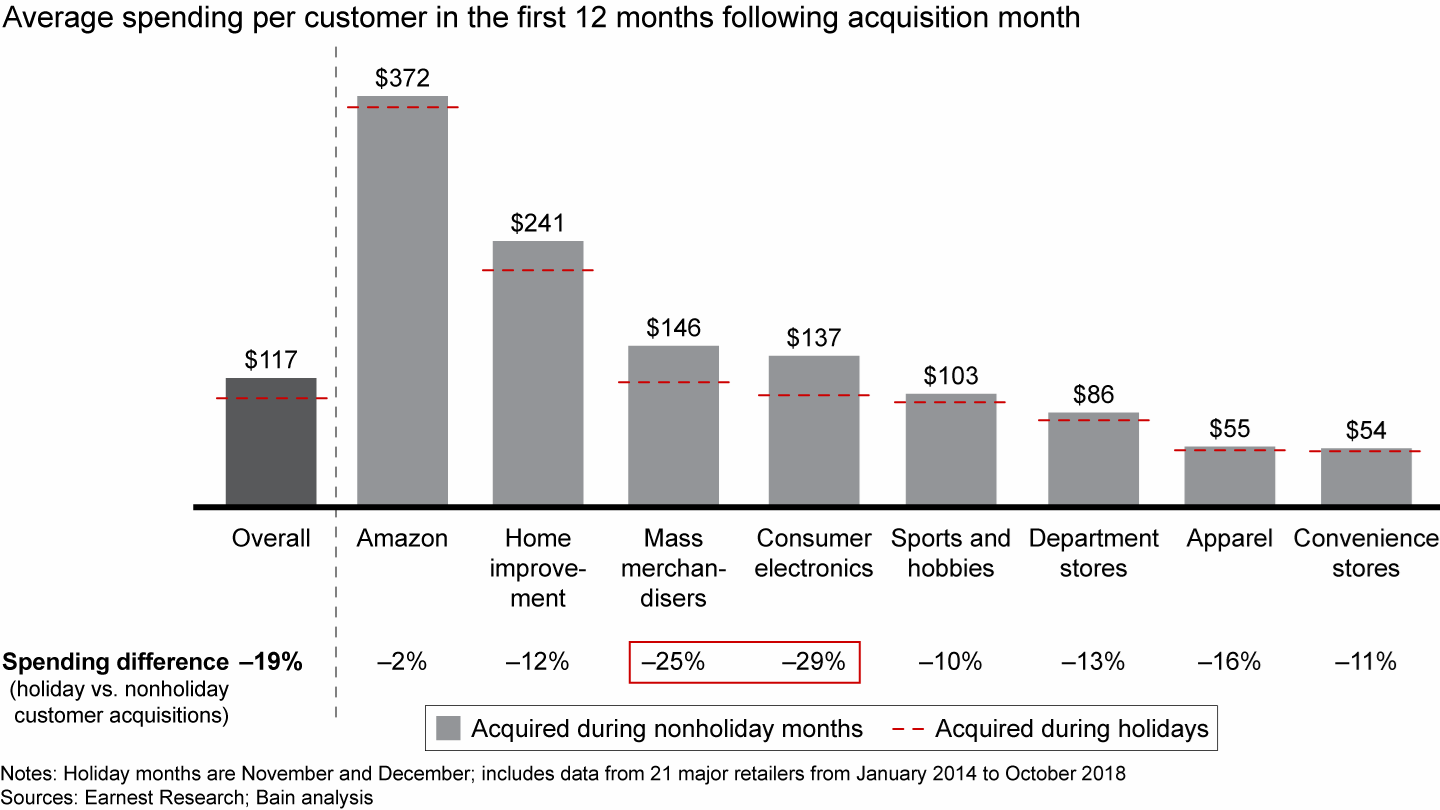
Despite the weaker customer lifetime values of individual holiday shoppers, the rewards of attracting many new customers can outweigh their reduced propensity to return. On average, retailers gain 26% more customers per month during November and December than during the rest of the year. Consumer electronics stores show the biggest increase in customers during the holiday season, 80%, followed by apparel retailers and department stores (see Figure 7). Convenience stores and home improvement retailers acquire fewer new customers during the holiday months. The spike in new customer acquisitions reflects the overall seasonality of these segments. As we saw in Figure 3, fourth-quarter revenue rises the most at apparel, sports and hobbies, and consumer electronics retailers, while home improvement retailers and convenience stores see the least change.
Most retailers acquire more new customers during the holidays, especially electronics and apparel stores
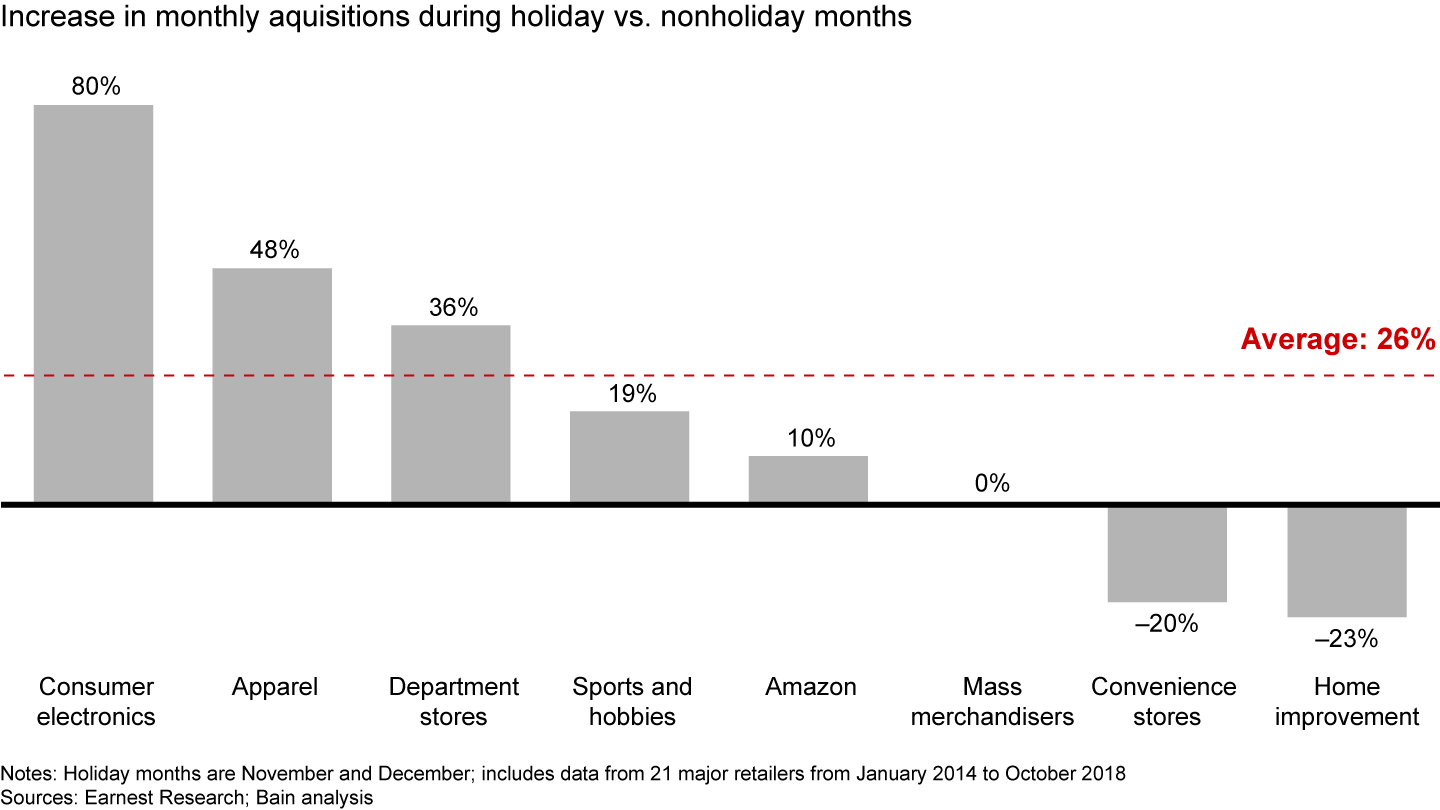
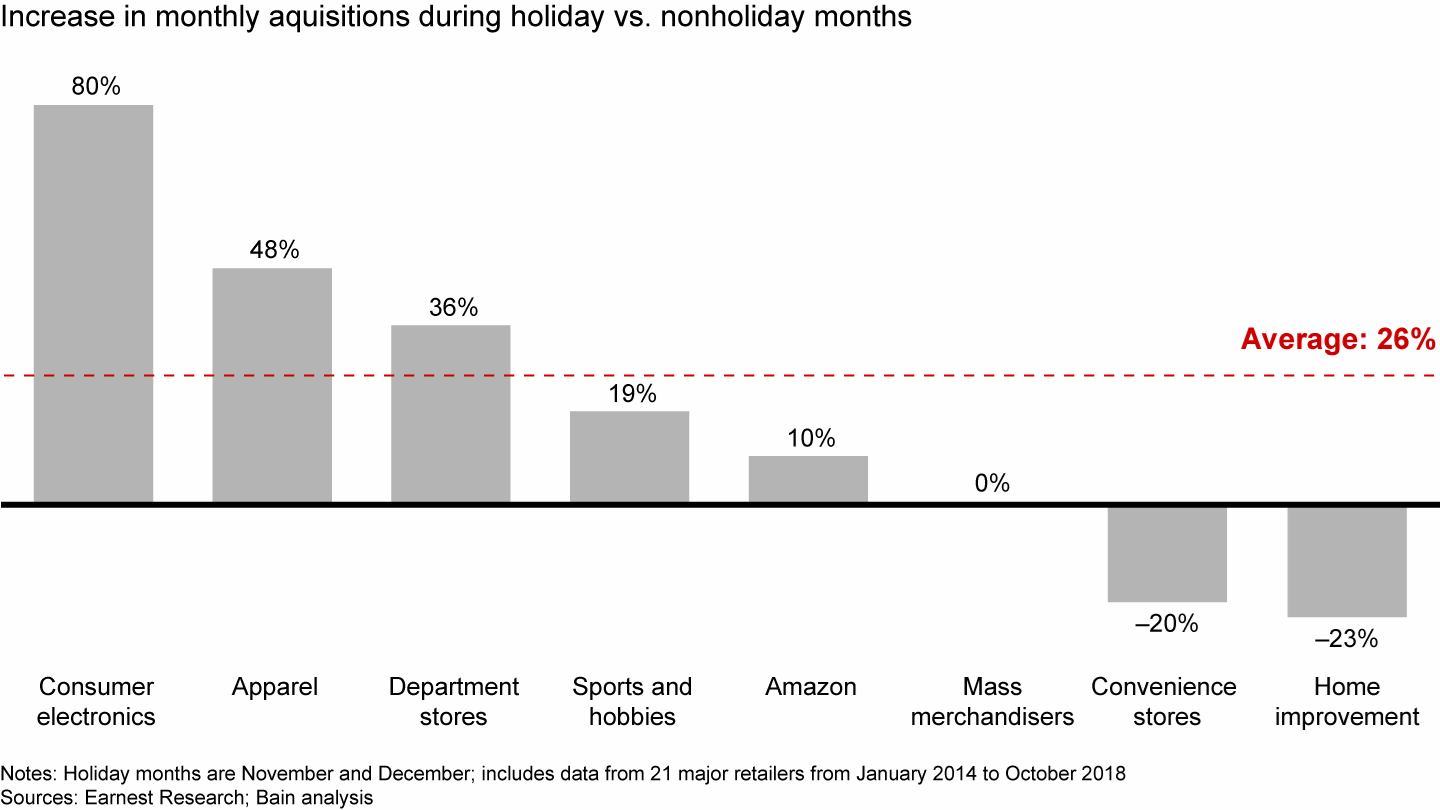
Tried-and-true tactics with a modern twist
To generate more repeat business, retailers are deploying many time-honored marketing approaches, but tailoring these tactics for the modern customer. These approaches include:
Enticing customers with promotional and discounted gift cards. Free or discounted gift cards remain a powerful tool to encourage repeat transactions. On Black Friday, Walmart offered $300 gift cards with the purchase of an iPhone XR or iPhone XS. Amazon gave an extra $10 to customers who purchased a $100 gift card. And Target held a one-day sale in which it offered gift cards of up to $300 at a 10% discount. Despite the discounts, retailers still emerge as winners. The International Card Manufacturers Association estimates that 2% to 4% of gift cards are never used. Among customers who use their cards, 59% spend more than their card’s value, according to a Blackhawk network consumer survey. The gift cards become tantamount to interest-free loans from consumers, who might not return until after the holidays.
Providing time-limited bounce-back incentives. Retailers want consumers to feel as though they are losing out by not returning to shop. Kohl’s, for example, not only cut the price of the popular Instant Pot cooking tool on Black Friday to $69.99 from the regular $140, but gave $15 of Kohl’s Cash that was valid for only 10 days after the purchase. Dick’s Sporting Goods also offered customers who purchased select The North Face items up to $50 in cash to use between December 12 and December 31. This “use it or lose it” strategy aims to capture more of customers’ holiday budgets.
Offering special experiences to loyalty program members. While discounts still appeal to customers, experiences are becoming a powerful draw. Perks such as access to special events or expedited checkout lines can inspire more loyalty than purely points-based programs, according to research from Gartner. Sephora has been testing this approach, revamping its Beauty Insider program to include makeovers as a reward option. Athleisure retailer Lululemon has been piloting a new loyalty program that offers members curated experiences, such as exercise classes, and free shipping for a $128 annual fee.
Harnessing data to engage customers on a personal level. Personalizing offers to customers is especially challenging after the holidays, as shoppers are frequently buying for others during the holiday season. Amazon customers send purchases to nonprimary zip codes at double the rate during the holidays (see Exhibit A), according to research we conducted with the analytics firm Pyxis. In an ideal state, retailers would be able to separate gifts intended for others from personal purchases to avoid muddying a customer’s profile. Technology can help retailers maintain high-quality consumer profiles that enable more personalized outreach. Customer data platforms—databases that collect and integrate data from various sources, including first-party transactions, and apply matching algorithms—can help retailers develop comprehensive behavior profiles by capturing and connecting more data than older approaches. These databases can feed data management platforms that centralize campaign and audience data from various sources. From there, a company can deploy predictive tools and machine learning to deliver the right marketing messages, at the right time, in an orchestrated way across channels.
Organizing customer data can require significant effort and investment, but the data shows it is worth it. Eight in 10 customers say they are more likely to buy from a company that offers personalized experiences, according to a study by data marketing firm Epsilon.
Segmenting the naughty customers from the nice
As the season wraps up, retailers will look for ways to extend relationships with new customers. While these new customers are worth 15% to 20% less, on average, than nonholiday acquisitions, some will naturally spend more and others have the potential for higher lifetime values, with the right triggers. But retailers must quickly identify these high-potential customers and align media spending accordingly. Saying the right thing to the right consumer at the right time can yield rewards for years to come.
Leading retailers constantly test different approaches and make real-time adjustments based on what they learn. During Thanksgiving weekend last year, a company that sells popular gift items closely monitored online sales during the first few hours of the critical shopping weekend. Traffic hit record levels, prompting the company to invest further and extend the campaign rather than halt it after a few hours as it initially planned. Thanks to this proactive adjustment, the company doubled its e-commerce sales targets and tripled its expected return on advertising spending.
While there is no one-size-fits-all approach, successful retailers will enter the New Year equipped with lessons from the season and a concrete plan to bring holiday shoppers back. Industry leaders will use this strong holiday season to create a ripple effect that propels their growth into 2019 and beyond.
The post-holiday recap and outlook
We hope you have a wonderful break over the holidays. We will be back in the New Year with our final issue of the season, “Bain’s Post-Holiday Recap and Outlook.”
Please let us know if you have other topics you would like to learn more about by emailing us at RetailHolidayNewsletter@bain.com. We look forward to sharing holiday headlines with you and hearing from you in the new year.
Appendix
During the holidays, Amazon customers send purchases to addresses outside their usual zip code at twice the rate
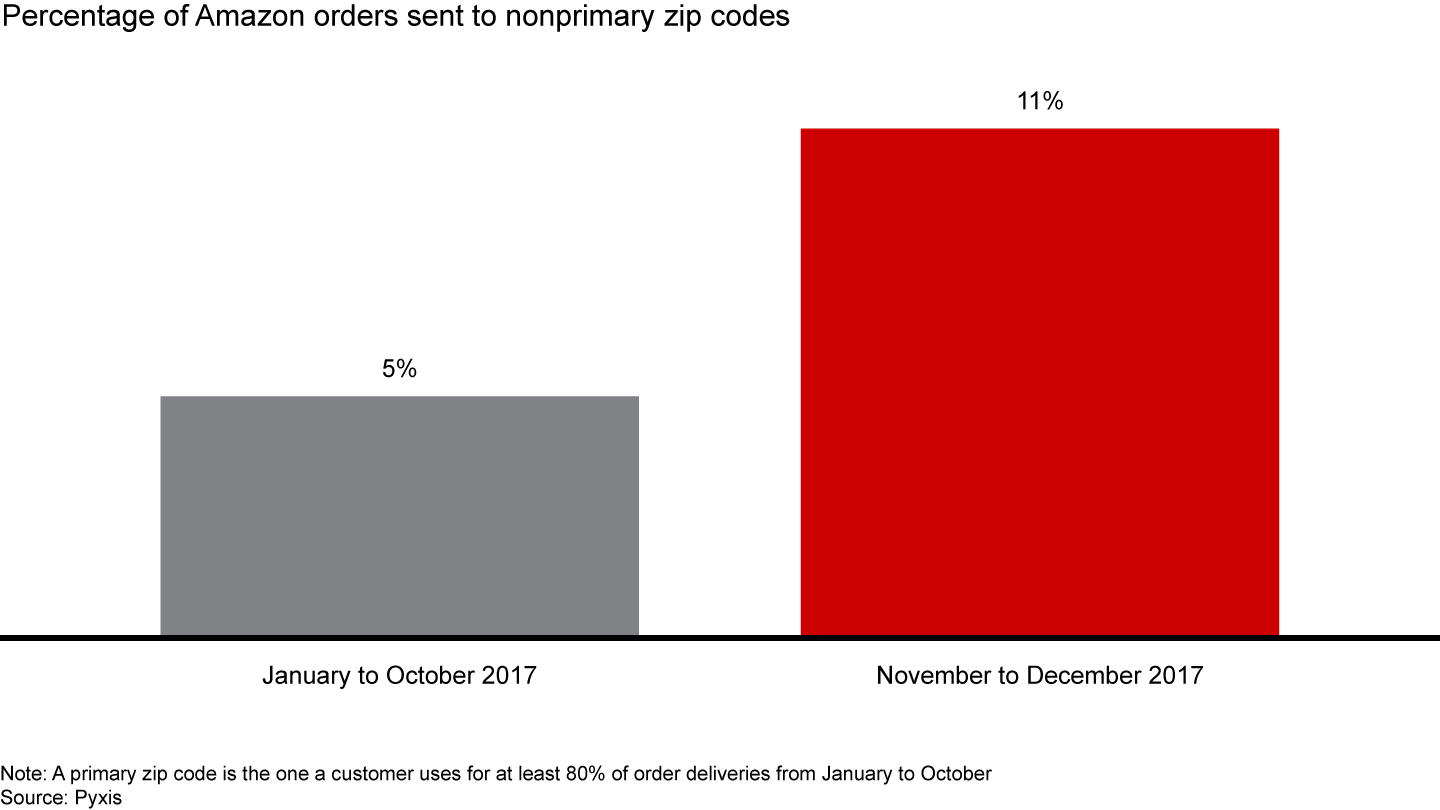
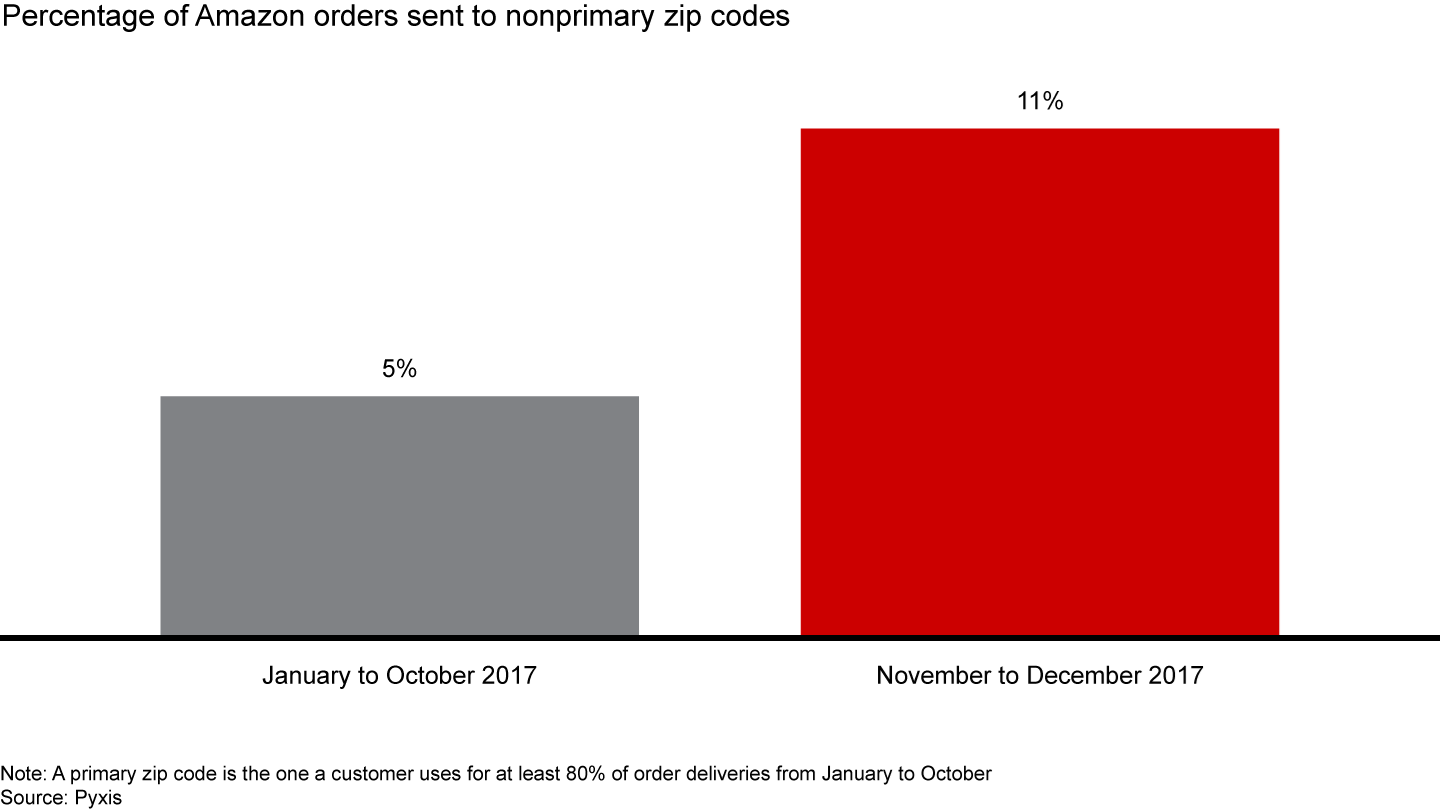
About Our Research Partners
Earnest Research provides market and consumer research that draws from the transaction data of millions of anonymous US-based consumers to consultants, investors and corporate clients. Using a proprietary full-wallet methodology and longitudinal cohort analysis, Earnest Research provides insight into consumer behavior trends and a comprehensive, unbiased look into competitive market dynamics. To learn more about Earnest Research, visit www.earnestresearch.com.
Green Street Advisors, an independent research firm, advises participants in the commercial real estate industry, providing them with unbiased insights and excellent service. Green Street offers public market REIT research in North America and Europe, covering more than 120 REITs; the firm also provides US private market research on the top 50 metropolitan statistical areas. To learn more about Green Street, visit www.greenstreetadvisors.com.
Jumpshot provides insights about online user actions that help e-commerce companies and brands gauge how and where customers are clicking and buying. The company’s real-time, anonymized global panel tracks 5 billion actions a day across 100 million devices. Jumpshot’s clients include major companies in industries such as consumer products, media, technology and healthcare. To learn more about Jumpshot, visit www.jumpshot.com.
Numerator is a market-intelligence firm that brings together omnichannel marketing, merchandising and sales data for brand, retail and agency clients. Owned by Vista Equity Partners, Numerator connects omnichannel purchase data (powered by the InfoScout OmniPanel) and comprehensive path data to deliver a detailed view of the consumer shopping and purchase experience. To learn more about Numerator, visit www.numerator.com.
Placer.ai is an advanced foot-traffic analytics platform that generates location-specific insights, helping retailers gain a deeper understanding of audiences and competition. Headquartered in Silicon Valley, Placer.ai enables its customers to make data-driven decisions based on precise human movement analytics. To learn more about Placer.ai, visit www.placer.ai.
Pyxis is a consumer-behavior analytics firm that analyzes billions of e-commerce and in-store purchases conducted by millions of consumers. Pyxis uses SKU-level data and proprietary algorithms to generate detailed reports about market share, market size, customer loyalty and pricing power for leading consumer companies. To learn more about Pyxis, visit www.pyxisintel.com.
SimilarWeb provides granular insights about websites and apps across all industries and in every region to help brands make better decisions. Companies use SimilarWeb to understand industry dynamics, reveal competitor strategies, benchmark performance and identify new opportunities. To learn more about SimilarWeb, visit www.similarweb.com.
-
Selected References (click to expand)
Bain & Company has included in this document information and analyses based on the sources referenced below as well as our own research and experience. Bain has not independently verified this information and makes no representation or warranty, express or implied, that such information is accurate or complete. Projected market and financial information, analyses and conclusions contained here are based (unless sourced otherwise) on the information described above, and Bain’s judgments should not be construed as definitive forecasts or guarantees of future performance or results. Neither Bain & Company nor any of its subsidiaries or their respective officers, directors, shareholders, employees or agents accept any responsibility or liability with respect to this document.
Bogost, Ian. “Why 'Stories' Took Over Your Smartphone.” The Atlantic, May 3, 2018.
Collins, Kimberly. “Social Media Stories on the Rise in 2018 Holiday Ads.” ClickZ, November 15, 2018.
Crosby, Jackie. “Gift Card Glam: Retailers Put on the Glitz to Make Gift Cards Stand Out from the Crowd.” Star Tribune, December 8, 2018.
“Facebook Holiday Study.” Ipsos Marketing, January 2016.
Jansen, Caroline. “Lululemon Expands Test for 1st Loyalty Program.” Retail Dive, December 7, 2018.
Kelly, Gordon. “Black Friday iPhone 2018 Deals: Best Buy, Target, Walmart And More.” Forbes, November 15, 2018.
Kohl’s Black Friday sales page. Kohls.com, accessed November 23, 2018.
Krause, Amanda. “Sephora Is Giving Its Most Loyal Fans More Points than Ever before—Here's How to Get Them.” Insider, August 9, 2018.
Lincoln, John. “The Holidays Are Coming: How to Outsmart Increasing Ad Prices and Get Better Returns.” Inc., November 9, 2016.
“MAGNA Advertising Forecasts Digital Advertising Soon to Grab 50% of All Ad Dollars.” MAGNA, March 21, 2018.
Marian, Kelsie. “Loyalty Is a No. 1 Investment Priority, but What's Next for Retail Loyalty Programs?” Gartner, Inc., February 26, 2018.
“New Epsilon Research Indicates 80% of Consumers Are More Likely to Make a Purchase When Brands Offer Personalized Experiences.” Epsilon, press release, January 9, 2018.
O'Neill, Megan. “2018 State of Social Video: Marketer Trends [Infographic].” Animoto, October 23, 2018.
“Preliminary Results for December 2018.” University of Michigan, data release, December 7, 2018.
Rozario-Ospino, Jessica. “2018 Holiday Social Media Trends [Infographic].” Animoto, November 14, 2018.
Sloane, Garett. “On Instagram TV, Brands Go Longer and Weirder.” Ad Age, July 12, 2018.
“The State of Consumer Gift Card Preferences in 2018.” Blackhawk Network Holdings, Inc., March 2018.
Tyko, Kelly. “Target's Massive One-Day Gift Card Sale Is Happening This Sunday.” USA Today, December 2, 2018.
1Green Street Advisors determines mall grades for each property based on merchandise mix, productivity, location, and condition/appeal.